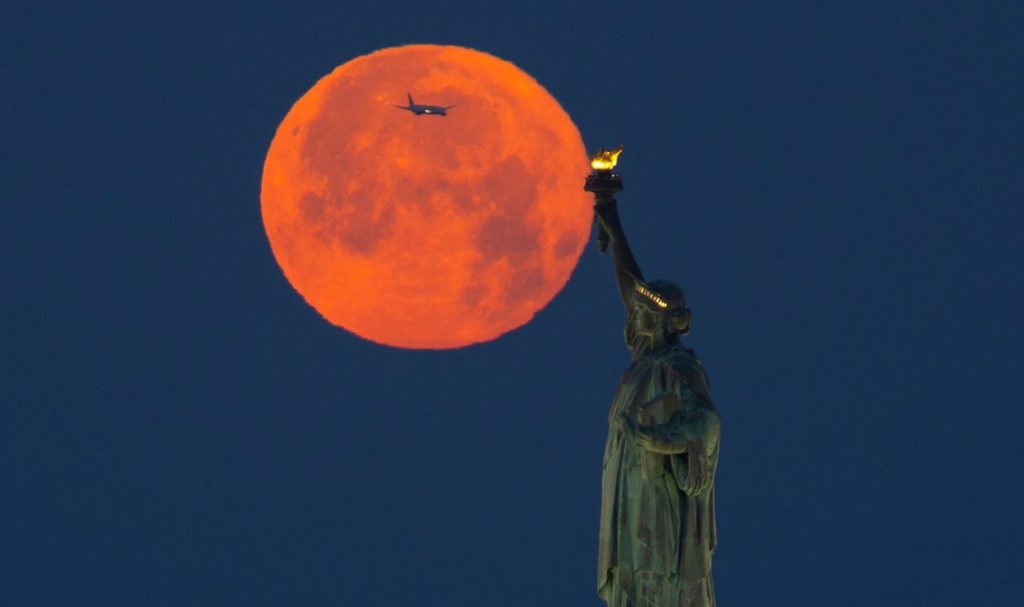Despite its name, June’s full moon will not look like a strawberry. But the bright orb could still turn heads Friday night with an appearance that is bigger and more colorful than the average moon.
The full moon — which will reach the crest of its fullness at 9:08 p.m. ET Friday — comes one day after the summer solstice, the day of the year when the sun appears the highest in the sky for the Northern Hemisphere. Since a full moon is opposite the sun, this strawberry moon will shine lower in the sky than usual, according to NASA.
Because of this “lower than average path across the sky,” the full moon could have an “orange- or amber-colored appearance, for the same reason sunsets appear orange or reddish,” said Preston Dyches, a science communicator with NASA’s Jet Propulsion Laboratory in Pasadena, California, in an email.
Dyches said the effect is the result of the moon’s reflected light having to travel a longer distance throughout Earth’s atmosphere, scattering away most blue wavelengths (which are shorter than red wavelengths).
Native American tribes across North America gave the strawberry moon its name to mark the in-season ripeness of strawberries, according to The Old Farmer’s Almanac.
The moon’s low placement in the sky could also cause the orb to appear bigger than usual, according to NASA, due to an effect dubbed the moon illusion. Scientists don’t really know why this optical illusion happens, but it’s believed to be a combination of how our brain processes visual information and the moon’s size in comparison with smaller objects near the horizon, such as trees or the roofs of houses.
For optimal viewing, Dyches recommends looking when the moon is rising or setting to see the effects of the moon illusion. No equipment is needed to view a full moon, but a telescope or pair of binoculars could enhance its features, according to NASA’s Moon Viewing Guide.
“Whenever something beautiful about the natural world can be experienced from your doorstep, it’s worth a few minutes of your time,” Dyches said. “It’s rewarding to marvel at the sight of another giant world. … I like to gaze up and think of it as a place people will live and work someday.”
How to see the ‘Summer Triangle’ in the night sky
Related Articles
NASA watchdog report: 100+ cracks on heat shield biggest threat to human moon mission
Solar eclipse: When it begins, and 4 other things to know
Because the moon appears full for three days a month surrounding its peak, the strawberry moon will be visible to almost everyone worldwide. However, it will be more difficult to observe for those farther north, such as in Alaska or Denmark, where the low-traversing moon will only briefly rise above the horizon, Dyches said.
Besides the full moon, those in the Northern Hemisphere can spot the “Summer Triangle,” an arrangement of three bright stars whose presence in the sky symbolizes summertime in the north, said Dyches, who also produces the space agency’s monthly sky-watching highlights video called “What’s Up.”
To find the triangular pattern, it is easiest to look for the brightest of the three stars, Vega, which will be near the east in the sky, according to EarthSky. The second brightest, Altair, will be to the lower right, and the star Deneb, to the lower left of Vega, will finish off the sides of the triangle.
Those away from bright city lights can spot the center of the Milky Way as a “hazy band of dim clouds arching across the sky,” and the constellation Scorpius can be seen as it “points the way to the galaxy’s core,” Dyches added.
Remaining moons of 2024
There are six more full moons set to shine bright in the sky this year, according to EarthSky. Here are the remaining full moons of 2024 and their peak dates:
July 21: Buck moon
August 19: Sturgeon moon
September 17: Harvest moon
October 17: Hunter’s moon
November 15: Beaver moon
December 15: Cold moon
The-CNN-Wire
& © 2024 Cable News Network, Inc., a Warner Bros. Discovery Company. All rights reserved.


